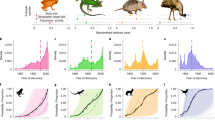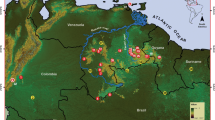Abstract
Even since Linnaeus, naturalists and taxonomists have been systematically describing species new to science. Besides indicating gaps in taxonomic effort, understanding the temporal patterns of species discovery could help in identifying drivers that determine discovery. In this study we report the patterns of discovery of eight taxa — birds, butterflies, frogs, tiger beetles, grasses, asters, ferns and orchids — in the Western Ghats, a megadiversity centre in India. Our results indicate that the discovery curves for birds and butterflies have been saturated while those for frogs and grasses continue to increase. Within each taxon, the major drivers of discovery were commonness of the species and their size. The average years taken for discovery across taxa were directly related to the per cent endemicity and species richness of the taxa. We discuss the trajectories of discovery with respect to rarity or endemicity of the species and life history features, and the implications these might have for strategizing the discovery process in India.
Similar content being viewed by others
References
Acciavatti R E and Pearson D L 1989 The tiger beetle genus Cicindela (Coleoptera, Insecta) from Indian subcontinent; Annals of Carnegie Museum 58 77–353
Ali S and Ripley S D 1983 Handbook of the birds of India and Pakistan (compact edition). (Bombay: Oxford University Press and BNHS)
Allsopp P G 1997 Probability of describing an Australian scarab beetle: influence of body size and distribution; J. Biogeogr. 24 717–724
Aravind N A 2005 Ecology of land snails of Western Ghats, Ph.D dissertation, Mangalore University, Mangalore, India
Aravind N A, Ganeshaiah K N and Uma Shaanker R 2004 Croak, croak, croak: are there more frogs to be discovered in Western Ghats? Curr. Sci. 86 1471–1472
Bhatta G K and Prashanth P 2004 Gegeneophis nadkarnii — a caecilian (Amphibia: Gymnophiona: Caeciliidae) from Bondla Wildlife Sanctuary, Western Ghats. Curr. Sci. 87 388–392
Bhatta G K and Srinivasa R 2004 A new species of Gegeneophis Peters (Amphibia: Gymnophiona: Caeciliidae) from the surroundings of Mookambika Wildlife Sanctuary, Karnataka, India; Zootaxa 644 1–8
Biju S D 2001 A synopsis of frog fauna of Western Ghats of India (Tiruvananthapuram: ISCB, TBGRI, Occasional publication 201)
Biju S D and Bossuyt F 2003 New frog family from India reveals an ancient biogeographical link with the Seychelles; Nature 425 711–714
Bingham C T 1905 The fauna of British India including Ceylon and Burma — Butterflies Vol. I (London: Taylor and Francis)
Bingham C T 1907 The fauna of British India including Ceylon and Burma — Butterflies Vol. II (London: Taylor and Francis)
Blackburn T M and Gaston K J 1995 What determines the probability of discovering a species? A study of South American oscine passerine birds; J. Biogeogr. 22 7–14
Blackburn T M, Brown V K, Doube B M, Greenwood J J D, Lawton J H and Stork N K 1993 The relationship between body size and abundance in natural animal assemblages; J. Anim. Ecol. 62 519–528
Bor N L 1960 The grasses of Burma, Ceylon, India and Pakistan (London: Pergamon Press)
Chanda S K 2002 Handbook of amphibians of India (Calcutta: Zoological Survey of India)
Dasappa and Swaminath M H 1999 A new species of Semecarpus (Anacardiaceae) from the Myristica swamps of the Western Ghats of North Kanara, Karnataka, India; Indian Forester 126 78–82
Diamond J M 1985 How many species are yet to be discovered?; Nature 315 538–539
Drury W H 1974 Rare species; Biol. Conserv. 6 162–169
Drury W H 1980 Rare species of plants; Rhodora 82 3–48
Dubois A, Ohler A and Biju S D 2001 A new genus and species of Ranidae (Amphibia, Anura) from south-western India; Alytes 19 53–79
Dutta S K, Vasudevan K, Chaitra M S, Shanker K and Aggarwal R K 2004 Jurassic frogs and the evolution of amphibian endemism in the Western Ghats; Curr. Sci. 86 211–216
Finney D J 1964 Probit analysis: statistical treatment of the sigmoid response curve (London: Cambridge University Press)
Gaston K J 1991a Body size and probability of description: the beetle fauna of Britain; Ecol. Entomol. 16 505–508
Gaston K J 1991b How large is a species geographic range? Oikos 61 434–438
Gaston K J and Blackburn T M 1994 Are newly described bird species small bodied? Biodiv. Lett. 2 16–20
Gaston K J and May R M 1992 The taxonomy of taxonomists; Nature 356 281–282
Gaston K J, Blackburn T M and Loder N 1995a Which species are described first? The case of North American butterflies; Biodiv. Conserv. 4 119–127
Gaston K J, Scoble M J and Crook A 1995b Patterns in species description: a case study using Geometridae (Lepidoptera); Biol. J. Linn. Soc. 55 225–237
Giri V, Wilkinson M and Gower D J 2003 A new species of Gegeneophis (Amphibia: Gymnophiona: Caeciliidae) from southern Maharashtra, India, with a key to the species of the genus; Zootaxa 351 1–10
Giri V, Wilkinson M and Gower D J 2004 A new species of Indotyphlus (Amphibia: Gymnophiona: Caeciliidae) from the Western Ghats, India; Zootaxa 739 1–19
Gower D J, Bhatta G, Giri V, Oommen O V, Ravichandran M S and Wilkinson M 2004 Biodiversity in the Western Ghats: the discovery of new species of caecilian amphibians; Curr. Sci. 87 739–740
Grimmett R, Inskipp C and Inskipp T 1999 Birds of Indian subcontinent (London: Oxford University Press)
Keshava Murthy K R and Yoganarasimhan S N 1990 Flora of Coorg (Kodagu) Karnataka, India: with data on medicinal plants and chemical constituents (Bangalore: VIMSAT Publishers).
Krishnamurthy S V, Manjunatha Reddy A H and Gururaja K V 2001 New species of genus Nyctibatrachus (Boulenger) from Kudremukh National Park; Curr. Sci. 80 887–891
Mayr E 1963 Animal species and evolution, (Cambridge, MA: The Belknap Press of Harvard University Press)
Moore F 1893–1896 Lepidoptera Indica Vol. 1–10 (London: Francis Taylor).
Nayar B K and Geevarghese 1989 Fern flora of Malabar (New Delhi: Indus Publishing Co).
Patterson B D 1994 Accumulating knowledge on the dimensions of biodiversity: systematic perspectives on neotropical mammals; Biodiv. Lett. 2 79–86
Rajagopal P K and Bhat K G 1998 Pteridophytic flora of Karnataka State, India; Indian Fern J. 15 1–28
Ramachandran V S and Nair V J 1988 Flora of Cannanore (Calcutta: Botanical Survey of India) pp 238–259
Rao A T 1998 Conservation of wild orchids of Kodagu in the Western Ghats (Bangalore: Karnataka association for advancement of science)
Ravichandran M S, Gower D J and Wilkinson M 2003 A new species of Gegeneophis peters (Amphibia: Gymnophiona: Caeciliidae) from Maharashtra, India; Zootaxa 350 1–8
Reed R N and Boback S M 2002 Does body size predict dates of species description among North American and Australian reptiles and amphibians? Global Ecol. Biogeogr. 11 41–47
Talbot G 1939 The fauna of British India including Ceylon and Burma — Butterflies, Vol. I (London: Taylor and Francis)
Talbot G 1947 The fauna of British India including Ceylon and Burma — Butterflies, Vol. II (London: Taylor and Francis)
Tangley L 1984 Protecting the “insignificant”; BioScience 34 406–409
Vajravelu E 1990 Flora of Palghat District, including Silent Valley national park, Kerala (Calcutta: Botanical Survey of India) pp 245–260
Vuilleumier F, LeCroy M and Mayr E 1992 New species of birds described from 1981 to 1990; Bull. Brit. Orn. Club Centenary Supplement 122A 267–309
Williams P H 1998 An annotated checklist of bumble bees with an analysis of patterns of description (Hymenoptera: Apidae, Bombini); Bull. Nat. Hist. Mus.(Entomology) 67 79–152
Wynter-Blyth M A 1957 Butterflies of the Indian Region (Bombay: Bombay Natural History Society)
Zacharias M and Priyadarsanan D R 2004a Discothyrea sringerensis (Hymenoptera: Formicidae) a new ant species from India; Zootaxa 484 1–4
Zacharias M and Priyadarsanan D R 2004b Vombisidris humboldticola (Hymenoptera: Formicidae) a new arboreal ant species from an Indian ant plant; Curr. Sci. 87 1337–1338
Zar J H 1999 Biostatistical analysis, 4th ed. (New Jersey: Prentice Hall)
Author information
Authors and Affiliations
Corresponding author
Rights and permissions
About this article
Cite this article
Aravind, N.A., Tambat, B., Ravikanth, G. et al. Patterns of species discovery in the Western Ghats, a megadiversity hot spot in India. J Biosci 32, 781–790 (2007). https://doi.org/10.1007/s12038-007-0079-z
Received:
Accepted:
Published:
Issue Date:
DOI: https://doi.org/10.1007/s12038-007-0079-z




